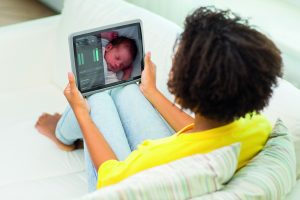Resting easy
 The quality of a child’s sleep can have a huge impact on their lives. According to the American Academy of Pediatrics, a quarter of children under the age of five do not get adequate sleep.
The quality of a child’s sleep can have a huge impact on their lives. According to the American Academy of Pediatrics, a quarter of children under the age of five do not get adequate sleep.
A continual lack of good quality sleep is linked to chronic behavioural problems, obesity, ADHD and a string of other medical issues. Inhibitors of sleeping such as snoring, caused by physiology or illness, can limit the body’s natural sleep cycles, especially the ability to enter deep sleep.
Bed wetting can also be linked to poor quality sleep and being in a deep sleep cycle reduces the body’s urine production. This has been shown in research on older adults, who, naturally, spend less time in deep sleep, and so have to visit the bathroom many times a night.
Typically, parents will sleep through much of the night, unless the child is physically waking up enough to disturb them, which means poor sleep patterns in children can often go undetected.
A bad night’s sleep can lead to aggressive behaviour and unwillingness to play in children and adults alike. In addition to parents and siblings dealing with their own problems caused by sleep deprivation, a disturbed night can have a disruptive impact on family life. Children are incapable of articulating or understanding the quality of their sleep, as it is generally outside their comprehension of the world. They can end up exhausted and will fall asleep during the day, disrupting their education and engagement.
Wireless data
Many of these issues are already being detected by child sleep monitors. The increased availability of low-cost sensors, low-power on-board processors and inbuilt artificial intelligence (AI) algorithms mean new developments are coming to market at accessible prices.
In the same way that the automotive industry has been able to develop autonomous driving solutions by using camera and radar systems to interpret and relay information on the environment and objects around a moving vehicle, child sleep monitors can collect and understand a child’s quality and quantity of sleep in great detail.
For decades, child monitor technology relied solely on microphones and portable speakers. The advent of inexpensive cameras and screens combined with high-speed wireless transmission meant that portable video monitors became widespread. Now, with the availability of low-cost radars, thermal cameras, blood oxygen sensors, machine learning, as well as fully encrypted smartphone alerts, technology can meet the expectation of full sleep analysis.
For those suffering from severe sleep disorders, adequate diagnosis is possible only at a properly staffed polysomnographic sleep clinic. This is an invasive process, requiring patients to participate in many hours of set up, observation and analysis to get to a diagnosis.
On the other end of the scale, personal sleep monitoring using fitness trackers is widespread, but is aimed at a more casual market of people looking to roughly evaluate their sleep. Despite the ability to measure arm motion and blood oxygen levels and with extrapolation to interpret sleep-cycle duration and quality, monitoring falls short of what a clinic study can reveal. Personal brain activity sensors, usually using an electrical pad behind the ear, are emerging for use but their use while sleeping does not seem practical.
The simple truth of the matter is that people are not willing to adapt their behaviour to gather more superfluous data about their lives unless it has been shown absolutely critical, such as we have seen through the Covid-19 pandemic. Wearing a watch in bed is probably about as far as behaviour adaption may go in order to track sleep.
A similar analogous technology would be heart-rate monitors in fitness trackers. Before the sensors were integrated into the watch, a separate wearable strap was required across the chest. The need for this addition was enough to stop the adoption of this heart-rate monitor, except for the fringe areas of the market. Now the sensor is in the watch itself and the barrier to entry is reduced.
Video monitoring
One methodology performed in polysomnography, which is contentious if implementing in personal sleep tracking, is video analysis. The technology to achieve this is readily available through inexpensive, high-quality night vision cameras, and on-the-fly machine learning video analysis. However, adults are rightly very concerned about their privacy, especially in the vulnerable state of sleep. Being video recorded during sleep will not become widespread in the teenage and adult population. However, these options are readily accepted when used in the care of younger children.
Typical mid-range baby monitors now include night-vision IR cameras and portable displays or transmission to smartphone apps. Even the most hawkish of helicopter parents are unlikely to stare at their children sleeping for hours on end. However, when a child is being disturbed, a video display can reveal the difference between random sleeping noises and something that requires the attention of parents.
The child monitor market has started to release products that cover aspects of sleep tracking, such as the SAMi camera, which alerts parents to irregular movements of the children being monitored. This analyses the video feed to detect the signs of epileptic seizures in the children, producing a loud alert or smartphone notification. This specialist end of the market is probably too narrow an application to encourage widespread adoption.
The Nanit Plus and Cubo Ai Plus monitors are the most fully realised camera-based sleep trackers, but currently occupy the top end in terms of price. The features that these models have will soon become affordable in mid-range devices for broader adoption.
Tracking model
Consider the fitness tracker market. In the past decade, the understanding of a personal fitness tracker has changed from being a digital watch with a timer, to having a computer with multiple sensors and outputs on the wrist. Developments in low-cost MEMS accelerometers, GPS tracking ICs, LED-based heart rate and blood oxygen monitors, low-power processing, and high-pixel density flexible displays have transformed what is possible to purchase for an affordable amount. This level of detail regarding your exercise routine would have previously been possible only for athletes with a huge infrastructure built around them. Now it is available to all.
Given the quantity of features on modern fitness trackers, there are plenty of possible applications that are barely used by the majority of users. So many features can be packed onto the device for an acceptable cost, and no change in the form factor of the design is needed. This means they are incorporated by the manufacturer.
The meteoric rise in the smartphone market has been the main driver for this technology development, and now these sensors and processors are available for many tertiary products. Consider what can be possible with video sleep monitors, developed for children but available for all, using these sensors.
GHz industrial radar solutions such as TI’s IWR6843 has inbuilt vital signs tracking. Thermal imaging, coupled with RGB and IR pixel image sensors, allows the scaling up of multiple-stream information collection. On board video analysis can be achieved through a plethora of AI systems such as the Jetson Xavier NX supercomputer. Coupled with connectivity through low-cost Wi-Fi and Bluetooth modules entire systems can now be envisioned at a cost that means they can be included in a standard sleep monitor.
The sensor data and on-board processing of the implementation of these new technologies could easily be integrated and assessed to provide a clear evaluation of the sleep cycles. This would allow parents to understand what factors might have contributed to the child’s poor night’s sleep, and to some extent predict the child’s behaviour. For example, body temperature readings could anticipate fevers, while ambient temperature readings would allow parents to appropriately dress children at night, as well as ventilate or heat the bedroom. Sleep cycles could also be linked to noise and light stimuli. Complex events such as sleepwalking would be recorded so that children could be kept safe.
This is the kind of data that smartwatches are trying to extrapolate from a wrist-worn device. With reduced privacy implications when monitoring children, this new analysis generated from video data can benefit parents and children alike. Alerts on a smartphone or watch warn parents of critically important information in the health and development of their children. We have the ability to create more sophisticated multi-sensor consumer devices to harness far more data and help parents to understand and improve the sleep patterns of their children as well as themselves.

